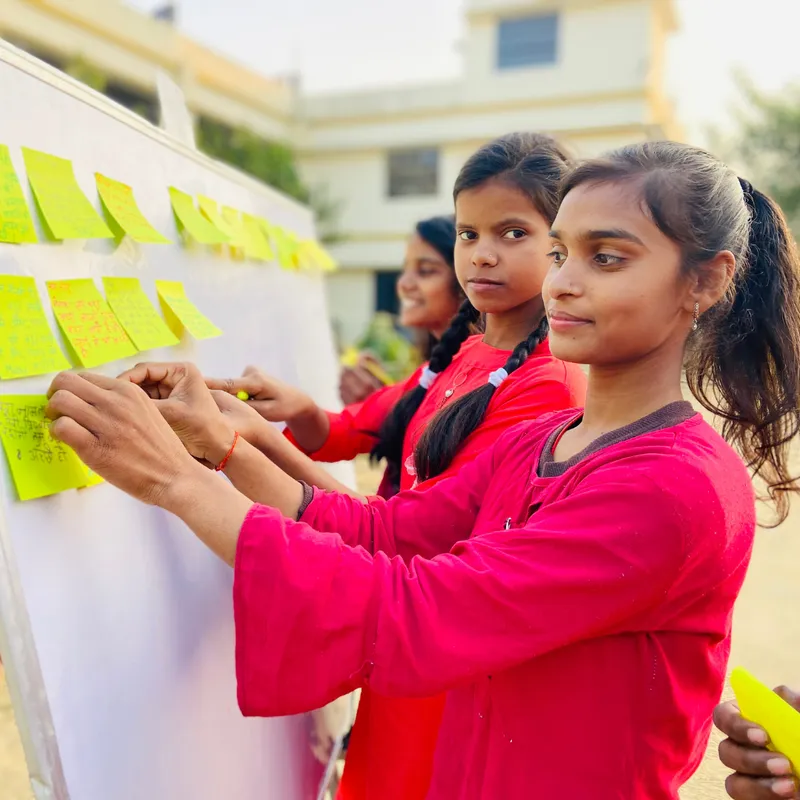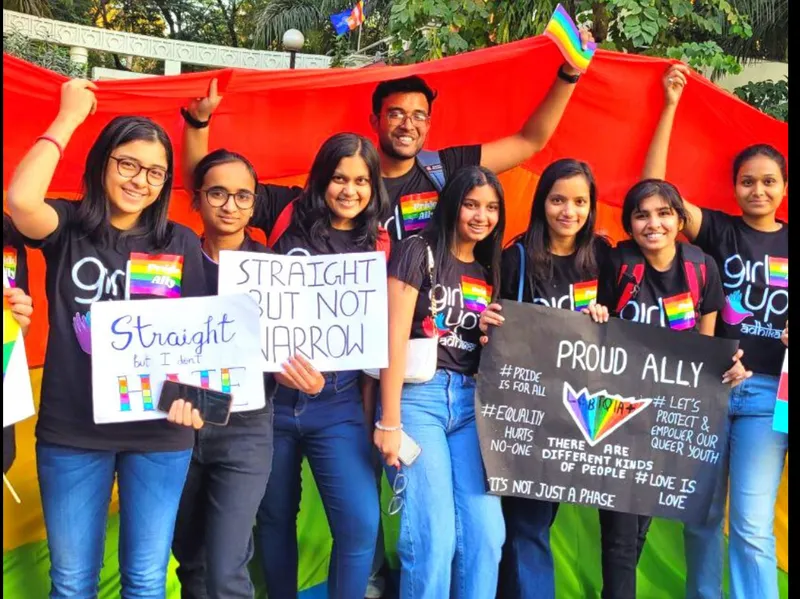How Girl Up India is helping shape leaders among young girls in schools, colleges and communities
Girl Up India is a leadership development initiative part of Girl Up, founded by the United Nations Foundation (UNF). It has over 22,000 participants between the ages of 13-24 years old till date.
When Girl Up was founded in 2010 by the United Nations Foundation (UNF)—it was set up an initiative that was one of its kind, specifically focused on supporting adolescent girls’ education, health, and safety.
It’s been 12 years since then and Girl Up has come a long way. Today, it stands as a movement that engages, trains, and mobilises girls and young people of all identities to be leaders.

Aditi Arora (extreme left) on field as part of a Girl Up India initiative
Its India chapter was initiated by Aditi Arora, Country Director, in 2018 when the organisation was looking to expand beyond the US into other countries.
“Girl Up was working on decentralising the movement and giving power to girls all over the world. I thought starting it in India would be the perfect fit,” Arora tells HerStory. “…I’ve always been interested in the girls’ movement. The initiative, founded by the UNF works on the 17 Sustainable Development Goals (SDGs) and focuses on SDG4 – ensuring inclusive and equitable and promoting lifelong opportunities for all”.
In India, over 22,000 girls between the ages of 13-24 are effecting change in 26 states and union territories of India through Girl Up Clubs in 129 schools, in 122 colleges and in 419 communities.
In September 2021, Girl Up India’s Delhi Coalition launched Project Hifaazat, a project aimed at raising funds for sex workers from GB Road, New Delhi in collaboration with NGO Kat-Katha. It was used to purchase sewing machines to provide sex workers with an alternative livelihood.
In the same year, through an online fundraising open mic ‘Saanjh sessions’, Girl Up Ikhtiyar raised ₹20,500. A portion of the funds was used to hold an exhibition in Champa Gali to mark 16 days of Activism against gender-based violence.
These are just a few examples of how Girl Up clubs across India are changing mindsets, breaking taboos, challenging stereotypes, and impacting lives, hoping to make a difference in the world they live in.
Bringing gender-related issues to the fore

In November last year, two new clubs were set up at Swarachna School in Sitapur, a village located close to Lucknow, Uttar Pradesh
Arora’s plan to start Girl Up in India began with boots to the ground. She operated solo, visiting schools and colleges to talk about gender equality and feminism. While in her life these matters were crystal-cut, the reality as she would come to know, couldn’t be more different.
“I first approached schools and colleges and while some seemed encouraging in the beginning, bureaucracy and relativism took over. A lot them were not keen on talking about sexuality, in fact, even an Ivy League kind of school in Gurugram didn’t want us to speak about sex education or the quota system,” she says.
In 2018, Girl Up India’s focus was on menstrual equity, because of Arora’s prior experience in the healthcare sector. She had previously worked with John Hopkins Center for Communication, followed by a UNICEF project on breast-feeding in India and the National Deworming Program.
In collaboration with UNHCR and FTFI, Girl Up India organised a menstrual pad donation drive for 130 refugee women in two locations across Delhi.
“I felt it is a basic biological function, and everybody should be talking about it, but if there’s so much taboo and misconceptions around it, we really double down on menstrual equity and period poverty. Both young girls and boys should be talking about it and creating spaces to debunk myths in their own families and communities,” points out Arora.
Slowly, the movement gained momentum to include a number of gender-related subjects – violence, doxing, trolling, cyber bullying, mental health, body positivity and more.
Girl Up India’s impact

Girl Up Adhikaar in collaboration with the Sarathi Trust organised a Pride March in Nagpur. Image credit: Girl Up India on Facebook.
At the ground level, Girl Up initiated clubs in schools and colleges, with the notion of empowering to girls by providing them with resources to manage and take the message forward. As part of its initiatives, it also has a STEM curriculum in place for the clubs, developed with the help of Carnegie-Mellon University.
“We also provide them with a seed grant from our funds to all the clubs, and every month we host a workshop or boot camp on a particular topic and also connect them to a community of like-minded people,” says Arora. “Girl Up Clubs are a space for young girls to share their thoughts, plan action-oriented initiatives and collaboration for amplified impact”.
There are also other registered clubs that are not attached to any institution. A girl has to be part of the club for a minimum of one year to receive a certificate of participation. The entire process works on a voluntary system. Clubs can also submit project proposals and apply for Girl Up Project Award to receive between $500 and $1,000 for their initiatives that is supervised by the parent organisation.
“The Girl Up Clubs saw a lot of traction during the pandemic when the girls stepped in as Covid warriors, helping people in need. We saw an exponential increase in the number of clubs registered, 547 new ones between 2020-22 and all of them were collaborating online. We expanded quite a bit during this period,” Arora says.
During the pandemic, Girl Up Noor provided smartphones to three girls of Government Girls Senior Secondary School, Uttam Nagar, so they could access lessons via the phones and download textbooks.
Girl Up clubs in schools and colleges have access to safe spaces within their institutions to organise activities and host meetings. There is also a teacher-in-charge to supervise girls in schools to ensure its smooth functioning.
While its impact is at the grassroots level, thus far the clubs have been restricted to schools and colleges in urban India.
“Girls need to have access to a stable internet connection and should have a working knowledge of English. However we do have two clubs in Swarachna School, Sitapur near Lucknow,” she adds.
Each Girl Up club operates under a committee of five including a president, a vice-president and secretary. The parent organisation, under UNF supervises them, and is in regular touch regarding their initiatives. The core team works with a team of four full-time staff and three part-time consultants, and is headed by Arora.
“Our plan is to have a Girl Up club in every school, college, community and not just in urban areas but in every village, district of the country, because everybody should have an equal chance to live up to their full potential irrespective of gender,” says Arora. “They also need a space and opportunity to share their stories and work on projects they are passionate about”.
Edited by Akanksha Sarma







